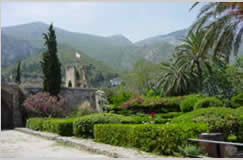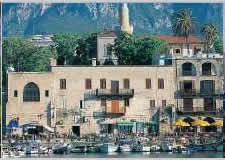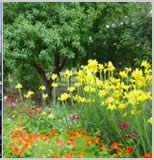



 |
 |
 |
 |
||||||||
Wild Orchids of Northern CyprusThe
Environment that we inherited and the next generation will inherit from
us, is worth of more awareness and love... There is a mysterious sense at
the word 'Orchid ... "It Has To Be Known To Love"
From this point on, we prepared this inventory of the orchids of our beautiful island, Cyprus. Our duties include the possession of orchids in a way to protect them by introducing them. Perhaps it will be suitable to begin our words saying: "What is orchid? and Is wild orchid present in the environment we live in? . The terms orchid anticipates an expensive plant with pleasant odour and eye-catching colours. It is generally presented to women. But beyond its prevalent image and being man s favourite for centuries, orchids, as mysterious individuals of the nature, are not far from us. Perhaps we met most of them during a picnic, or during a walk we had with friends in the country but we didn't noticed them perhaps we were not interested in them. If you get acquainted with orchids or get interested in them for the first time, our web site will be a good guide for you at the beginning. All the plants, covered in this web site are the orchid growing naturally in Northern Cyprus. Of these thirty two taxon, one is endemic to Cyprus. The others are the members widespread in five continents. With this information, we prepared and presented, both botanic specialists and passionate amateurs lowers of nature will have the opportunity to know closely the orchids of Northern Cyprus. The family Orchidaceae, thought to have originated from the Liliaceae family, is one of the largest and most evolved plant families in the entire plant kingdom. Orchids (Orchidaceae) comprise the most diverse family of plants, with over 25,000 described species in 400 to 800 genera worldwide. The Amazon is among the world's richest sources of native orchids, from where thousands of species are described and many more undoubtedly remain to be discovered. Orchids are differ from other flowering plants because they have: their stamens and pistils (male and female parts) fused together in one structure known as a column three petals and three petal-like sepals usually has one different petal that forms a lip or labellum making the flower laterally symmetrical the pollen is usually bound together in a few large masses known as pollinia their flowers twists around during development known as resupination. Ecology of Orchids The ecology of orchids is a complex topic as the flowers themselves. Orchids have a large habitat diversity and can be found almost anywhere in the world, especially in tropical and warm temperate regions. Many orchids live on other plants (epiphytic), on decayed material (saphrophytic) or independent as usual plants (auto trophic). Nearly all orchids are pollinated by insects notably bees and wasps, but also butterflies, ants, flies and others. Moreover, almost every orchid species is pollinated by just one or two kinds of insects. Even though there are plentiful, many of them may go extinct if its pollinator insect dies out. North Cyprus Orchids Because of their rarity and beauty, orchids hold a special fascination for all naturalists. At North Cyprus, the orchid flora consists of 32 confirmed species, subspecies and varieties and a further three or five which presence needs verifying. Some species will be familiar to botanists from north-western Europe, such as pyramidal orchid and autumn lady's tresses, but there are also more exotic species including violet limodore, tongue-flowered serapias, naked man orchid and more. No doubt more observant botanists will find these and other orchid species more frequently but we think it s true to say that they are localised and hence always a delight when stumbled upon. Orchis italica Perennial herbs with two ovoid or ellipsoid tubers. Leaves up to 10, bright green, rosulate, Stem erect up to 50 cm, with cailine leaves. Inflorescence dense and many flowered. The flowers resemble a naked man. Pinkish-white with pink dots. Species grows in grigue, in maquis, or under Pine forest, sometimes in damp grassy hillsides on calcareous soils from sea-level to 1000m. Flowering period March-April. Dactylorhiza romana Perennial herbs with 2-3 tubers. Stem erect, up to 35cm. Leaves up to 10, mostly rosulate, oblong to linear-lanceolate. Inflorescence few to many flowered, cylindrical, lax or dense. Flowers spurred, bright yellow or pale yellow coloured and unspotted. Species grows at dry rocky places in Pine forests, often in association with Orchis morio ssp. Picta from 150 to 1000m. Flowering period March – May. Neotinea maculata Tuberous perennial herbs. Stem up to 40 cm, pinkish-purple and glaucous. Leaves rosulate and cauline, 2-6, spotted or unspotted. Inflorescence dense, many flowered. Flowers white, yellowish, pink or pinkish-purple. Species grows in garig, under Pinus or Cupressus foreste, usually on calcareous soils from 100 to 1000m. Flowering period March – April. Orchis papilonacea Tuberous perennial herbs, with stem up to 50 cm. Leaves up to 10, mostly rosulate, unspotted. Inflorescence up to 14 flowered, lax or dense. Flowers dark pink, red to purple with darker nerves and spots. Species grows in garigue or in dry grassy places on calcareous soils near the sea-level. Flowering period March-April. Spiranthes spiralis (L.) Chevall. Perennial herbs, roots tuberous and fleshy, stem up to 35 cm. Leaves unspotted, fleshy, basal and cauline. Inflorescence spirally twisted, flowers numerous, white, scented species grows on grassy banks and in sand dunes, \ .acier garigue 01 Pinus from sea-level to 300 m. Flowering period September-November. Orchis simia Perennial herbs with two ovoid or ellipsoid tubers. Stem erect up to 45cm. Leaves 3-6, bright green, unspotted, rosulate and sometimes with stem leaves. Insloresence dense and many flowered. Flowers white with dark pink tips. Species grows in garigue, and grassy places, on stony slopes, in Pine forests, on calcareous soils from 500 to 1000m. Flowering period April – May. Ophrys bornmuelleri ssp. Bornmuelleri Distinguished from O. bornmuelleri ssp. bornmuelleri by its with more compact and less elongated inflorescence, up to 7 flowered. Labellum brownish, hairy, with creamy yellow shoulders and h-shape, below shoulders, without creamy yellow bordered. Species grows at damp grassy places, in garigue, under Pine or Cypress, on calcareous soils from 100 to 700 m. Flowering period March-April. Orchis collina Tuberous perennial herbs. Stem up to 40 cm, rather fleshy often red or purplish. Leaves rosulate and cauline, dark green. Inflorescence lax, up to 20 flowered. Flowers variable in colour ranging from violet to creamy white. Species grows in garigue or in sandy or stony places mostly on calcareous soils from sea-level to 400 m. Flowering period February-March. Limodorum abortivum (L.) Swartz. Plants usually robust. Stem is thick, erect, up to 80 cm, violet, violet-red or bluish-violet and resembles an asparagus. Inflorescence a spike-like raceme up to 25 flowered. Sepals and petals pale to dark violet. Species grows in Pine forests, dry grassy places, on calcareous soils from 800 to 1000 m. Flowering period April-June. Serapias vomeracea (Burm.fil.) Briq.ssp. orientalis W.Greuter Perennial herbs up to 30 cm. Leaves 4-6, broadly lanceolate bluish to yellowish-green. Inflorescence condensed with 3-6 flowered. Flowers of all Serapias species have a lip divided into two, a front section and 2 side section. The front section reminds a tongue. This sub-species has larger front lip or tongue than the S. vomeracea ssp. laxiflora. Species grows in damp calcareous or slightly acidic soils under Olive or Pine trees from sea-level to 400 m. Flowering period March-May. Serapias vomeracea ssp. Laxiflora Perennial herbs up to 60 cm. Leaves 4-7, linear to lanceolate unspotted. Inflorescence elongate with up to 10 flowered. All Serapias flowers, just like Ophrys flowers have similar shape, resemble a tongue and this sub-species has smaller front lip or tongue than S. vomeracea ssp. orientalis. Species grows primarily in calcareous damp soils from sea-level to 800 m. Flowering period March-April. Serapias parviflora. Ophrys fusca ssp. Fusca erennial herbs with two ovoid tubers. Leaves up to 6, rosulate, narrow or broad elliptic. Inflorescence lax, up to S flowered. Labellum, which resembles an insect in outline, is brownish with two paler eye-shaped dots near its top, and a narrowyellow margin is characteristic. Species grows under Pine, Cypress, Olive or Cistus, in garigue or at limestone hills or on calcareous places from sea-level to 1000 m. Flowering period February-April . Ophrys fusca ssp. Fleischmanii Perennial herbs with two ovoid tubers. Leaves up to 6, rosulate, narrow or broad ellipti0c. Inflorescence lax, up to 10 insect shaped flowered. Labellum is brownish-yellowish and white w-shaped line divide it into two clear parts. Species grows in garigue or under Pine forests, on calcareous soils from SOO to 1000 m. Flowering period February-April. Ophrys fusca ssp. tricolor Perennial herbs with two ovoid tubers. Leaves up to 6, rosulate, narrow or broad elliptic. Inflorescence lax, up to 5 insect shaped flowered. Labellum is brownish with two blue eye-shaped dots near its top. Species grows, in garigue or under Pinus or Cistus, from sea-level to 1000 m. Flowering period February-April. Ophrys lutea ssp. galilaea Perennial herbs with two ovoid tubers. Stem up to 40 cm. Leaves 4-8, all basal forming a rosette. Inflorescence lax, up to 7 flowered. Insect shaped flowers resemble O. fusca ssp. fusca but düs one has wider yellow margin. Species grows in garigue or stony places under Pines or Olives on calcareous soils from sea-level to 1000 m. Flowering period February-April. Ophyrs bornmuelleri ssp. grandiflora Perennial herbs with two tubers. Stem up to 40 cm. Leaves 3-4, all basal except 1 at stem. Subspecies bornmuelleri with very lax, elongated inflorescence, up to IS flowered. Labellum, brownish, hairy, with cream) yellow shoulders and creamy yellow bordered h-shape below shoulders. Species grows in garigue, under pines or at grassy places, on calcareous soils from sea-level to 1000 m. Flowering period March-April. Ophrys sphegodes ssp. Mammosa Perennial herbs with two oblong or ovoid tubers. Stem up to 80 cm., bearing up to 4 cauline leaves. Inflorescence lax up to 10 flowered. Insect shaped parts of the flowers blackish and has bright purplish h-shaped lines. Species grows in garigue or under Pines, on calcareous soils from sea-level to 1000m. Flowering period March-June. Ophrys sphegodes ssp. Transhyrcana Distinguished from O. sphegodes Mammosa by its narrower insect shaped parts (Labellum) of flowers. Special grows in garigue or under Pines, often in damp places, on calcareous soils from 100 to 1000 m. Flowering period March-April. Ophrys apifera var. Chlorantha Perennial herbs with two globose tubers. Leaves up to 9, dark greei mostly rosulate. Stem up to 50 cm., bearing 1-2 cauline leaves. Inflorescence lax, up to 17 flowered. Labellum entire, green, yellowish-green or pink, with distinct appendage at its lower end and two yellowish dots above the appendage. Horseshoe shaped dots near the neck of the labellum. Species grows on sandy or on calcareous soils, approximately at 200 m. Flowering period April. Ophrys argolica ssp. Elegans Perennial herbs with two small globose or ovoid tubers. Leaves 3-4 mostly basal. Stem up to 35 cm., bearing 2-3 cauline leaves. Inflorescence lax, up to 6 flowered. Labellum nearly entire, pale pinkish-violet, lilac or purple, with soft hairs on the shoulders. Central area of the labellum with spectacle shaped metallic purple spot. Species grows at grassy, shady places under Pine, Cypress, in garigue or on sand dunes or on calcareous soils from sea-level to 1000 m. Flowering period February-March. Ophrys kotschyi Perennial herbs with two ovoid tubers. Leaves dark green, all basal except 1 at stem. Inflorescence up to 10 flowered. Sepals pale pink with green nerves and petals olive green, purple tinged at centre. Shoulders hairy and tips yellow tinged. Only Cyprus endemic orchid species. Species grows at grassy, shady places under Pine, Cypress, also under Acacia and Eucalyptus, in garigue or on sand dunes or on calcareous soils from sea-level to 1000m. Flowering period March-April. Ophrys scolopax Perennial herbs with two globose or elliptic tubers. Leaves up to 10 and grouped at the base. Stem up to 60 cm. Inflorescence lax, up to 12 flowered. Insect shaped part of the flower narrower, brownish with purplish neck. Shoulders hairy and appendage tri-lobed. Species grows at shady places under Pine or Cypress, in garigue or on dry turf from 100 to 1000m. Flowering period March-June. Ophrys umbilicata ssp. Umbilicata Perennial herbs with two tubers. Leaves up to 8, mostly basal. Stem up to 45 cm with 1-2 cauline leaves. Inflorescence up to 12 flowered. Insect shaped part labellum with white bordered brownish spots, one at the centre and two below shoulders. Shoulders hairy and labellum with yellowish appendage at the bottom. Species grows at variable habitats from sea-level to 800 m. Flowering period March-April. Ophrys umbilicata ssp. Attica Distinguished from O. Umblicata ssp. Umbilicata by its longer shoulders, wider labellum and smaller yellowish appendage at the bottom. Species grows in garigue, shady places under Pine, Cypress, or in dry turf, on calcareous soils from sea-level to 300 m . Flowering period March-April Barlia robertiana Herbaceous perennials with 2-3 large tubers. Leaves 5-8 large, unspotted and grouped at the base of the stem. Cauline leaves amplexicaul and much smaller. Stem up to 80 cm. Inflorescence long, many flowered. Flowers large, scented, white or pink with central area white and spotted pinkish. Monotypic genus, widespread in the world from sea-level to 500 m. Flowering period February-March. Orchis anatolica var. anatolica Plant perennial, herbaceous with two tubers. Stem up to 50 cm. Leaves 2-5, oblong or elliptic, rosulate, dark green with dark spots or blotches. Inflorescence lax up to 14 flowered. Flowers white, pale pink and purple with red spots. Species grows in garigue, in stony places, in light forest on calcareous soil from 150 to 1000 m. Flowering period March-May. Orchis morio ssp. Picta Tuberous perennial herbs, with stem up to 70 cm. Leaves up to 9, mostly rosulate sometimes 1-2 cauline, unspotted. Flowers yellowish-green, yellow or brownish-yellow with reddish dots. Species grows in garigue, on dry stony or sandy slopes, on calcareous soils from 100 to 300 m. Flowering period February. Orchis coriophora ssp. Fragrans Tuberous perennial herbs. Stem up to 60 cm. Leaves rosulate up to 10 and with several leaves above, unspotted. Inflorescence dense and many flowered. Flowers purple, red or reddish purple, three red spotted and sweet scented. Species grows in garigue and dry grassy places and by the roadsides on calcareous soils from sea-level to 600 m. Flowering period April-May. |
| © 2005 - 2016 Distinctive Properties Ltd. |
|